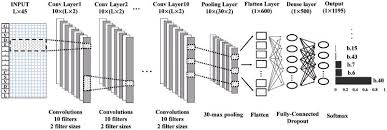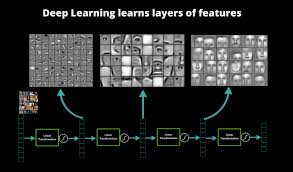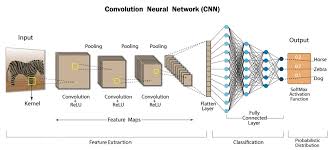Convolutional Neural Networks (CNNs) have revolutionized the field of deep learning, particularly in the realm of image recognition and computer vision. While CNNs are commonly associated with two-dimensional data, such as images, they can also be applied to one-dimensional data through a specialized architecture known as a one-dimensional Convolutional Neural Network (1D-CNN).
1D-CNNs operate similarly to their 2D counterparts, but are designed to process sequential data, such as time series or audio signals. By applying convolutional filters across the input sequence, 1D-CNNs can learn hierarchical features that capture patterns and dependencies within the data.
One key advantage of 1D-CNNs is their ability to automatically extract relevant features from raw input, eliminating the need for manual feature engineering. This makes them particularly well-suited for tasks like speech recognition, sentiment analysis, and bioinformatics, where capturing temporal dependencies is crucial.
The architecture of a typical 1D-CNN consists of convolutional layers followed by pooling layers to downsample the learned features. This is often followed by one or more fully connected layers for classification or regression tasks. Training a 1D-CNN involves optimizing the network parameters using backpropagation and gradient descent algorithms.
Researchers and practitioners continue to explore the capabilities of 1D-CNNs in various domains, seeking to leverage their power in extracting meaningful representations from sequential data. With ongoing advancements in deep learning techniques and hardware acceleration, 1D-CNNs are poised to play an increasingly important role in analyzing and understanding complex sequential data.
Understanding 1D Convolutional Neural Networks: Key Concepts and Differences
- What is 1D convolutional neural network?
- What is a 1 dimensional convolution?
- What is the difference between 1D and 2D CNN?
- What is the difference between using 1D CNN and Lstm?
- What is a 1D convolutional neural network?
- What is the difference between CNN and 3D CNN?
- Can CNN be used for 1D data?
- Why do some CNNs use 1×1 convolutions?
What is 1D convolutional neural network?
A one-dimensional Convolutional Neural Network (1D-CNN) is a specialized neural network architecture designed to process sequential data, such as time series or audio signals. Similar to its two-dimensional counterpart used in image recognition, a 1D-CNN applies convolutional filters to the input sequence to extract hierarchical features that capture patterns and dependencies within the data. This automated feature extraction capability makes 1D-CNNs well-suited for tasks like speech recognition, sentiment analysis, and bioinformatics, where understanding temporal relationships is essential. By utilizing convolution and pooling layers, along with fully connected layers for classification or regression, 1D-CNNs can effectively learn from sequential data and make accurate predictions.
What is a 1 dimensional convolution?
A frequently asked question about one-dimensional Convolutional Neural Networks is, “What is a 1-dimensional convolution?” In the context of deep learning, a one-dimensional convolution involves applying a filter or kernel to sequential data along one dimension, typically representing time or sequence order. This operation computes the dot product between the filter and a small section of the input sequence, allowing the network to extract features that capture patterns and dependencies within the data. By sliding the filter across the input sequence, a 1D-CNN can learn hierarchical representations that are essential for tasks like speech recognition, sentiment analysis, and time series forecasting.
What is the difference between 1D and 2D CNN?
One frequently asked question in the realm of Convolutional Neural Networks (CNNs) is about the distinction between 1D and 2D CNN architectures. The main difference lies in the dimensionality of the input data they are designed to process. While 2D CNNs are tailored for analyzing two-dimensional data, such as images with height and width dimensions, 1D CNNs are specialized for handling one-dimensional sequential data, like time series or text sequences. The key difference in their design is how convolutional filters are applied across the input: in 2D CNNs, filters move in two dimensions (height and width), capturing spatial patterns, while in 1D CNNs, filters move along a single dimension to capture temporal dependencies and patterns within sequential data.
What is the difference between using 1D CNN and Lstm?
When comparing the use of a one-dimensional Convolutional Neural Network (1D-CNN) and Long Short-Term Memory (LSTM) in deep learning tasks, the key distinction lies in their architectural design and how they capture temporal dependencies in sequential data. While 1D-CNNs excel at automatically extracting hierarchical features from raw input through convolutional filters, LSTMs are specifically designed to model long-range dependencies and sequential patterns by utilizing memory cells and gates to retain and update information over time. In essence, 1D-CNNs are well-suited for capturing local patterns in sequential data, such as short-term dependencies, while LSTMs are more adept at modeling complex, long-term dependencies and context in sequences. The choice between using a 1D-CNN or LSTM often depends on the nature of the data and the specific task requirements, with researchers and practitioners leveraging the strengths of each architecture to achieve optimal performance in various applications.
What is a 1D convolutional neural network?
A 1D convolutional neural network, often abbreviated as 1D-CNN, is a specialized deep learning architecture designed to process sequential data, such as time series or audio signals. Similar to traditional CNNs used for image recognition, a 1D-CNN applies convolutional filters across the input sequence to extract relevant features and capture patterns within the data. By leveraging the hierarchical learning capabilities of convolutional layers, a 1D-CNN can automatically learn and represent complex temporal dependencies in the input data without the need for manual feature engineering. This makes 1D-CNNs particularly effective for tasks that involve analyzing sequential information, such as speech recognition, sentiment analysis, and genomic sequence classification.
What is the difference between CNN and 3D CNN?
When comparing a Convolutional Neural Network (CNN) with a 3D CNN, the key distinction lies in the dimensionality of the input data they are designed to process. A traditional CNN is optimized for two-dimensional data, such as images, where each pixel has spatial relationships with its neighboring pixels. On the other hand, a 3D CNN is tailored for three-dimensional data, commonly used in applications like video processing or medical imaging, where the additional dimension represents frames or slices over time or depth. While both architectures share similarities in their convolutional and pooling operations, a 3D CNN incorporates an extra dimension to capture spatiotemporal features within the input volume. This enables 3D CNNs to model dynamic patterns and temporal dependencies present in sequential data, setting them apart from their 2D counterparts.
Can CNN be used for 1D data?
Yes, Convolutional Neural Networks (CNNs) can indeed be used for processing one-dimensional (1D) data. While CNNs are most commonly associated with image data in two-dimensional (2D) arrays, they can also be adapted to handle sequential data in a one-dimensional format. By applying convolutional filters across the input sequence, a specialized architecture known as a one-dimensional Convolutional Neural Network (1D-CNN) can effectively learn and extract features from the 1D data. This allows CNNs to be utilized for tasks involving time series analysis, audio signal processing, natural language processing, and other sequential data applications where capturing temporal dependencies is essential. The use of 1D-CNNs demonstrates the versatility and adaptability of convolutional neural networks across different types of data structures and domains.
Why do some CNNs use 1×1 convolutions?
One frequently asked question regarding one-dimensional Convolutional Neural Networks (1D-CNNs) is why some CNN architectures incorporate 1×1 convolutions. The use of 1×1 convolutions in CNNs serves multiple purposes, such as increasing the non-linearity of the network without significantly increasing computational complexity, reducing the number of parameters in the model, and enabling dimensionality reduction. By applying 1×1 convolutions, CNNs can learn complex patterns and interactions within feature maps while maintaining efficiency and scalability. This technique is particularly useful in improving network performance and generalization for tasks involving one-dimensional data, such as time series analysis and signal processing.




